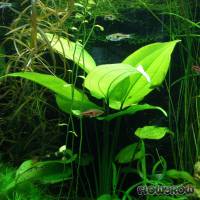



Echinodorus tunicatus resembles the related E. horizontalis very much, and in northern South America it even occurs in some of the latter's habitats (e.g. in Yasuní National Park, Ecuador). However, its area of distribution stretches farther to the north to Central America (Panama and Costa Rica). This plant grows in smaller waterbodies with a muddy to humous ground in bogwoods, often in better-lit places than E. horizontalis.
Whereas Echinodorus horizontalis forms long, low-lying flower stalks with adventitious plants and a relatively low number of flowers, the short inflorescence of E. tunicatus grows upright. It has a thick axis and a large number of flowers per whorl. In general, there are no adventitious plants on the flower stalks of E. tunicatus, and the flower stalks do not grow higher than the leaves. The leaf stalks are grouped closer together, and the blades of the submersed leaves are narrower than those of E. horizontalis. The leaves of both species are longish-heartshaped, acuminate, and they have round, smooth leaf stalks and almost horizontal leaf blades. Both species have another thing in common: the transparent patterns (pellucid markings) in their leaves form a grid crossing the leaf veins.
In science, E. tunicatus has been known for over 100 years, however, only in 2004 the first live specimens were brought to Europe from Ecuador. Up to now, this species could only be propagated in low numbers by sowing the nutlets and by in-vitro-propagation. It is not available in trade yet and is only cultivated by few hobbyists. E. tunicatus is sure to remain a rarity.
In the aquarium, Echinodorus tunicatus grows slowly. Its medium-sized rosette is formed by upright leaves that grow closely together. The leaf blades are almost horizontal. Softer water and a substrate rich in nutrients are recommendable, moderate light is sufficient. This plant can also be cultivated emersed, e.g. in paludaria, given that the air humidity is very high.
- follows -
<a href="https://www.flowgrow.de/db/aquaticplants/echinodorus-tunicatus" target="_blank"><img alt="Echinodorus tunicatus" title="Echinodorus tunicatus" src="https://www.flowgrow.de/db/widget/aquaticplants/echinodorus-tunicatus" /></a>
[url=https://www.flowgrow.de/db/aquaticplants/echinodorus-tunicatus][img]https://www.flowgrow.de/db/widget/aquaticplants/echinodorus-tunicatus[/img][/url]
[widget=aquaticplants/echinodorus-tunicatus]Echinodorus tunicatus[/widget]